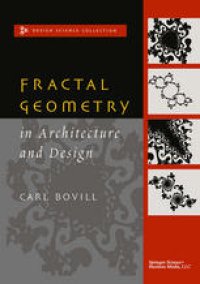
Ebook: Fractal Geometry in Architecture and Design
Author: Carl Bovill (auth.)
- Genre: Mathematics // Geometry and Topology
- Tags: Applications of Mathematics, Geometry, Architecture general, Design general
- Series: Design Science Collection
- Year: 1996
- Publisher: Birkhäuser Basel
- Edition: 1
- Language: English
- pdf
na broad sense Design Science is the grammar of a language of images Irather than of words. Modern communication techniques enable us to transmit and reconstitute images without needing to know a specific verbal sequence language such as the Morse code or Hungarian. International traffic signs use international image symbols which are not specific to any particular verbal language. An image language differs from a verbal one in that the latter uses a linear string of symbols, whereas the former is multi dimensional. Architectural renderings commonly show projections onto three mutual ly perpendicular planes, or consist of cross sections at different altitudes capa ble of being stacked and representing different floor plans. Such renderings make it difficult to imagine buildings comprising ramps and other features which disguise the separation between floors, and consequently limit the cre ative process of the architect. Analogously, we tend to analyze natural struc tures as if nature had used similar stacked renderings, rather than, for instance, a system of packed spheres, with the result that we fail to perceive the system of organization determining the form of such structures. Perception is a complex process. Our senses record; they are analogous to audio or video devices. We cannot, however, claim that such devices perceive.
Fractal geometry is the formal study of mathematical shapes that display a progression of never-ending, self-similar, meandering detail from large to small scales. It has the descriptive power to capture, explain, and enhance one's appreciation of and control over complex diversity. Natural shapes and rhythms, such as leaves, tree branching, mountain ridges, flood levels of a river, wave patterns, and nerve impulses, display this cascading behaviour. These fractal concepts are found in many fields, from physics to musical composition.
Architecture and design, concerned with control over rhythm, and with such fractal concepts as the progression of forms from a distant view down to the intimate details, can benefit from the use of this relatively new mathematical tool. Fractal geometry is a rare example of a technology that reaches into the core of design composition, allowing the architect or designer to express a complex understanding of nature.
The exposition of the book is at a level suitable for applied scientists, architects, and students with a modest background in mathematics. It is well illustrated and has numerous examples from which to learn the underlying concepts and their applications. Thus the book is addressed to a wide audience with a multiplicity of interests in new compositional ideas.
Fractal geometry is the formal study of mathematical shapes that display a progression of never-ending, self-similar, meandering detail from large to small scales. It has the descriptive power to capture, explain, and enhance one's appreciation of and control over complex diversity. Natural shapes and rhythms, such as leaves, tree branching, mountain ridges, flood levels of a river, wave patterns, and nerve impulses, display this cascading behaviour. These fractal concepts are found in many fields, from physics to musical composition.
Architecture and design, concerned with control over rhythm, and with such fractal concepts as the progression of forms from a distant view down to the intimate details, can benefit from the use of this relatively new mathematical tool. Fractal geometry is a rare example of a technology that reaches into the core of design composition, allowing the architect or designer to express a complex understanding of nature.
The exposition of the book is at a level suitable for applied scientists, architects, and students with a modest background in mathematics. It is well illustrated and has numerous examples from which to learn the underlying concepts and their applications. Thus the book is addressed to a wide audience with a multiplicity of interests in new compositional ideas.
Content:
Front Matter....Pages i-xii
Introduction....Pages 1-8
Basic Fractals....Pages 9-22
The Fractal Dimension....Pages 23-46
Feedback and Iteration....Pages 47-71
Random Fractals, Midpoint Displacement, and Curdling....Pages 73-101
Natural and Fractal Fluctuations in Time, Noise, and Music....Pages 103-113
Fractal Concepts Applied to Architectural and Design Criticism....Pages 115-155
Fractal Concepts Applied to Design....Pages 157-188
Back Matter....Pages 189-195
Fractal geometry is the formal study of mathematical shapes that display a progression of never-ending, self-similar, meandering detail from large to small scales. It has the descriptive power to capture, explain, and enhance one's appreciation of and control over complex diversity. Natural shapes and rhythms, such as leaves, tree branching, mountain ridges, flood levels of a river, wave patterns, and nerve impulses, display this cascading behaviour. These fractal concepts are found in many fields, from physics to musical composition.
Architecture and design, concerned with control over rhythm, and with such fractal concepts as the progression of forms from a distant view down to the intimate details, can benefit from the use of this relatively new mathematical tool. Fractal geometry is a rare example of a technology that reaches into the core of design composition, allowing the architect or designer to express a complex understanding of nature.
The exposition of the book is at a level suitable for applied scientists, architects, and students with a modest background in mathematics. It is well illustrated and has numerous examples from which to learn the underlying concepts and their applications. Thus the book is addressed to a wide audience with a multiplicity of interests in new compositional ideas.
Content:
Front Matter....Pages i-xii
Introduction....Pages 1-8
Basic Fractals....Pages 9-22
The Fractal Dimension....Pages 23-46
Feedback and Iteration....Pages 47-71
Random Fractals, Midpoint Displacement, and Curdling....Pages 73-101
Natural and Fractal Fluctuations in Time, Noise, and Music....Pages 103-113
Fractal Concepts Applied to Architectural and Design Criticism....Pages 115-155
Fractal Concepts Applied to Design....Pages 157-188
Back Matter....Pages 189-195
....